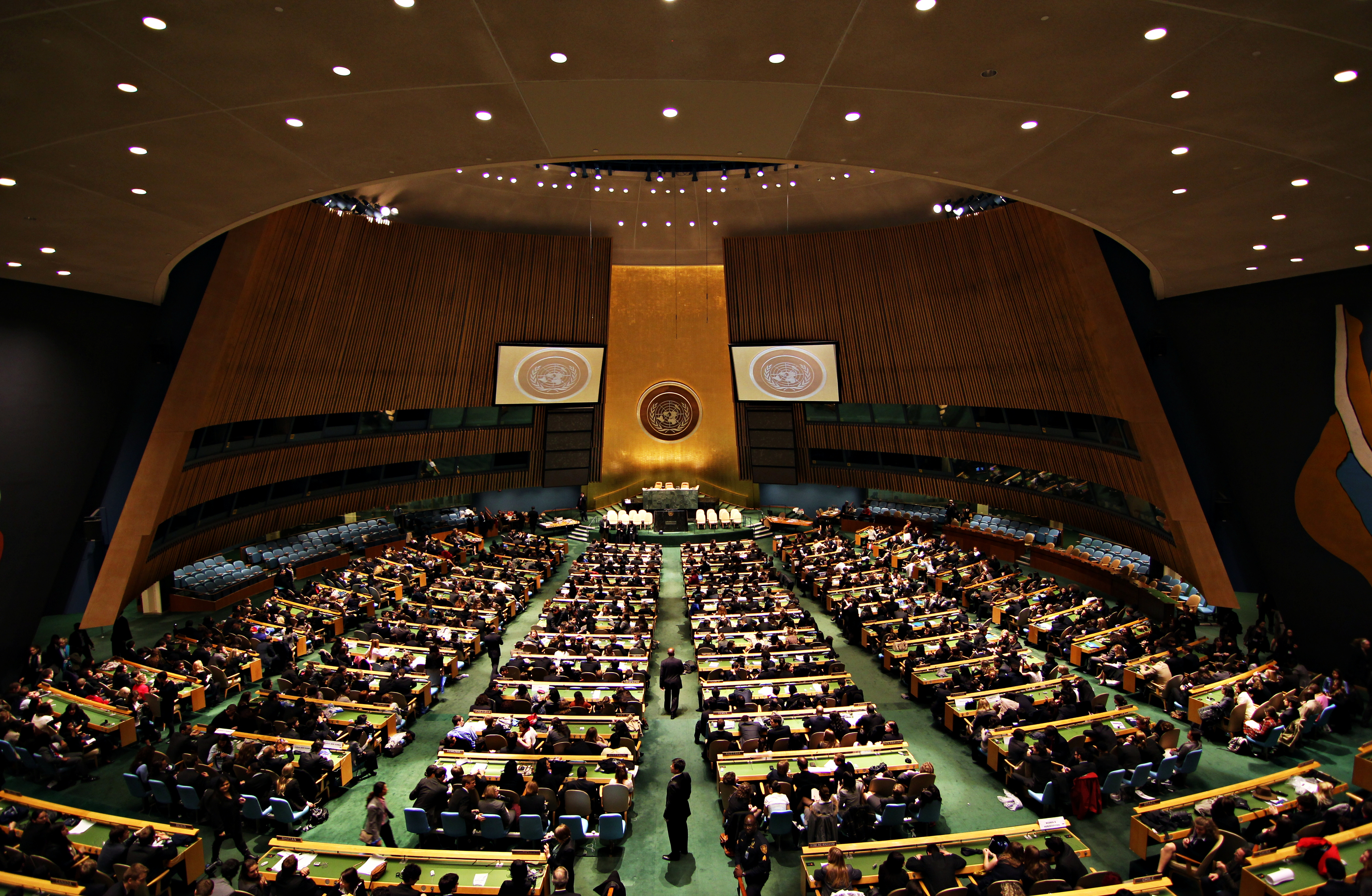The euphoria that accompanied the creation of the United Nations in 1945 has long since given way to frustration and disappointment. Established in the aftermath of the death and destruction of World War II to “save succeeding generations from the scourge of war,” it has succeeded in preventing another global war, but peace still remains illusory.
Armed conflicts in Syria, Iraq, Afghanistan, Libya, the Congo, Yemen, and other places attest to this grim reality. And the killing fields of Cambodia, the genocide in Rwanda, and the tragedy of Srebrenica show the international community’s failure to make good on its promise.
Benefiting from the experience of the failed League of Nations, the U.N. founders proclaimed in its charter the main purposes: to maintain international peace and security, to promote and protect human rights, and to effectively address pressing international economic and social issues such as development through international cooperation.
For a fair assessment of the U.N. on its 70th anniversary this fall, we need to look at its record in achieving these goals.
Under the U.N. framework, the Security Council, in which the veto power is wielded by five permanent members — China, France, Russia, the United Kingdom and the United States — is primarily responsible for peace and security. The founders envisioned that these five members would provide an umbrella of collective security for the world. That is why these became the only countries exclusively authorized to possess nuclear weapons.
But the Cold War quickly intervened. The U.S. and the Soviet Union — then the two superpowers — were embroiled in a prolonged ideological struggle, which led to an era of client states and proxy wars. The outcome was a paralyzed Security Council and stillbirth of the collective security system. This period lasted until the collapse of the Soviet Union.
At that time, there was renewed promise that the five permanent members (P-5) would work together to fulfill the expectations of the Security Council’s role on peace and security, and the first Gulf War showed a glimpse of that possibility. But the window again closed with Russia and the West at loggerheads on several geopolitical issues.
This tussle notwithstanding, the P-5 have found their interests aligned on countering terrorism, piracy, nuclear nonproliferation, on imposing collective sanctions on Iran, and now the Iran nuclear deal. They have also given their blessings to peacekeeping operations, and President Obama is to host a peacekeeping summit in New York in September. But more often, they disagree, such as on Syria.
Because the collective security apparatus did not work, the U.N. instituted peacekeeping as a band-age for trouble spots. From the early days of U.N. peacekeeping between India and Pakistan, these operations have expanded considerably, now in 16 countries with an enhanced mandate to protect civilians.
More than 100,000 personnel from more than 100 countries are engaged. The operation is costly — $8 billion-plus — and there are tremendous challenges. Critics often point to inefficiencies and abuses in the system, which badly needs clearly defined mandates, selection of peacekeepers based on experience and training, an effective oversight process, and well-defined exit strategies. The value of these operations, however, cannot be overstated.
The geopolitical circumstances have shifted the landscape. The 50 original charter signatories have grown to 193. No longer are peace and security issues confined to conflicts between and among states, as non-state actors such as the Islamic State, terrorists, and criminal elements challenge the traditional structure. And mass migration, climate change, environmental degradation, food insecurity, and violent extremism, among other forces, are major global security problems.
More than 50 million people are forcibly displaced today, and given the tragic incidents of hundreds of asylum-seekers drowning in the Mediterranean Sea and thousands on the move in Europe, the international community is undoubtedly failing them. Will the U.N. system, which is already showing its age, be able to deliver on these challenges?
On human rights, the U.N. indeed has undertaken impressive initiatives. Given the vivid demonstration of the Nazi Germany’s atrocities at home and aggression abroad, the founders realized that peace and security and human rights are inextricably intertwined. Accordingly, human rights found a place of honor on the U.N. agenda. The Universal Declaration of Human Rights, adopted in 1948, followed by binding international treaties on civil and political rights and economic, social, and cultural rights, culminated in an “international bill of rights.”
Since then, a number of international agreements have set universal standards for the promotion and protection of the rights of women, children, indigenous peoples, and disabled persons, for example. International agreements on the prohibition of atrocity crimes — genocide and torture, ethnic cleansing, and war crimes — and the creation of an International Criminal Court to hold egregious violators accountable are attempts to end all impunity. And credit for the independence of dozens of former colonial states goes to the U.N.’s decolonization process.
The U.N. World Conferences on Women — especially the 1995 Beijing Conference — set the goals of gender equality, active participation of women in decision-making, reproductive rights, and voluntary family planning. U.N. Women, a U.N. entity, now has a universal mandate to promote the women’s rights agenda.
Impressive international agreements are now in place on a wide range of other issues of human interaction, including the environment, the Earth’s ozone layer, the oceans, trade, outer space, terrorism, disarmament, aviation and shipping. The U.N. specialized agencies are addressing these issues. For example, the World Health Organization leads the global response to pandemics by creating awareness and mobilizing member states’ quick action on these threats.
The U.N. is attempting to shape a livable future on earth through a “sustainable development agenda,” which envisions linkage between economic viability, social development, and environmental aspects. It is an effort to bridge the initial North-South divide under which the developed states focused primarily on environmental protection, and developing countries on development needs. In 2005, the U.N. adopted the Millennium Development Goals, which focused on reducing poverty, hunger and child mortality, ensuring women’s empowerment, and providing clean water. Many of these goals, set to expire at the end of this year, have been largely met, and in September the U.N. will launch the Sustainable Development Goals, to last until 2030. These goals aim at ending poverty and hunger in all their forms everywhere, achieving gender equality, and ensuring access to clean water, sanitation, and affordable, reliable, and modern energy for all.
Indeed, the U.N. has had spectacular successes and monumental failures. It provides this interdependent world a platform where nations can enter into dialogue and negotiate to resolve their conflicts and address pressing challenges. Undoubtedly the organization suffers from a large bureaucracy, mismanagement, and inefficiency. Its governance structure has pointedly come under harsh criticism, a valid concern, indeed.
Currently the expansion of the Security Council is a contentious issue. Among the P-5 there is no representation from Africa or Latin America. The Asia-Pacific region, which comprises 55 percent of the world’s population and 44 percent of its annual income, has just one representative: China. This calls the Security Council’s legitimacy into question, and on Sept. 14 the General Assembly renewed the efforts for reform.
The veto power, which is responsible for the impasse and hence inaction at the Security Council to solve crises such as Syria, should be altered. But the P-5 defend it, and none would be willing to relinquish it. To illustrate, the Russian ambassador to the UK recently called the permanent members’ right to veto, a guarantee of checks and balances. And any alteration of the U.N. governance structure would require two-thirds of the membership of the General Assembly, 129 votes, not an easy task.
Secretary-General Ban Ki-moon’s term expires at the end of 2016. Jockeying for the job is in full swing. While East Europeans feel that it is their turn and the former president of Slovenia is a strong contender, there is powerful sentiment that the time is ripe for the first woman to take the helm.
There is truth in the cliché that if we did not have a United Nations we would have to invent one. However, while it is accurate that the U.N. can do only what its members will let it do, it must have the capacity to adapt to the changed geopolitical setting and a new economic and social landscape. Crucial questions are how to end red tape and bureaucracy; how to ensure effective monitoring and accountability mechanisms; and how to bring the governance structure in tune with modern-day realities.
Unless they are answered, the U.N.’s capability to effectively address the challenges and crises of the present and future is in question. The United States, which acknowledges the benefits of U.N. membership, must give its full support.
Article written by Ved Nanda (vnanda@law.du.edu) is Thompson G. Marsh Professor of Law and director of the Nanda Center for International and Comparative Law at the University of Denver Sturm College of Law. Culled from the Denver Post.




